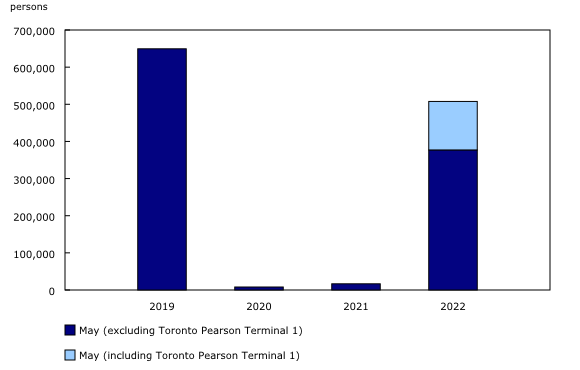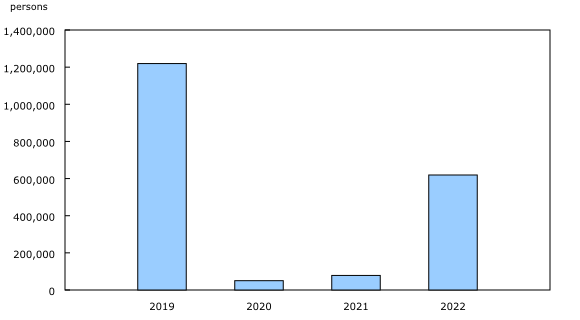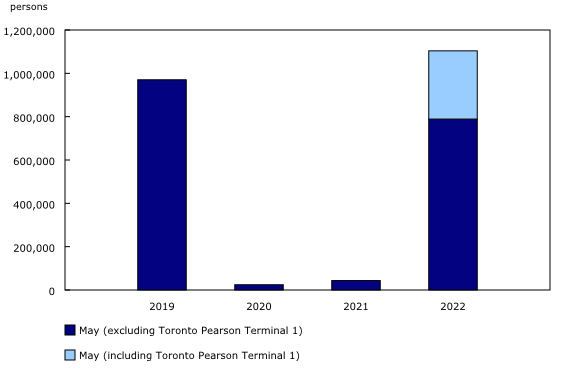Leading indicator of international arrivals to Canada, May 2022
Released: 2022-06-13
Highlights
In May, the number of international arrivals to Canada rose sharply from May 2021, continuing to approach levels recorded in the same month in 2019, before the COVID-19 pandemic.
Compared with May 2021, there were 30 times as many non-resident visitors (507,600) arriving from abroad at Canadian airports equipped with electronic kiosks.
US residents took 619,200 trips to Canada through land ports with electronic sensors in May 2022, over 540,000 more than in May 2021.
At the same time, the number of Canadian residents returning by air from visiting abroad via kiosk-equipped airports was much greater than in May 2021.
Compared with May 2021, over 1 million more Canadian residents—for a total of 1,365,300—returned from trips to the United States through land ports with electronic sensors.
This release provides a first glimpse of international arrivals to Canada in May 2022. Complete counts for May will be available in the "Travel between Canada and other countries" release on July 22, 2022.
Border restrictions further eased
As of April 1, 2022, fully vaccinated travellers were no longer required to provide a negative pre-entry COVID-19 test result to enter Canada by air, land or water; however, passengers could still be subjected to random PCR testing upon arrival.
On April 25, 2022, partially vaccinated or unvaccinated children aged 5 to 11 accompanied by a fully vaccinated adult were no longer required to complete a pre-entry COVID-19 test, nor were travellers required to provide a quarantine plan. However, all travellers, regardless of citizenship or vaccination status, were required to use the ArriveCAN app to declare their health information within 72 hours before arrival in Canada.
The requirement to be fully vaccinated with a government-approved COVID-19 vaccine to board federally regulated air, rail and marine transportation remains in effect until June 30.
Non-resident arrivals by air
Arrivals of non-resident visitors from overseas countries (263,500) and the United States (244,100) at Canadian airports equipped with primary inspection kiosks (PIKs) totalled 507,600 in May 2022, 30 times the number of arrivals (16,700) observed in May 2021.
Despite this sharp increase, non-resident arrivals still numbered below the 649,300 who arrived by air during the same month in 2019, before the pandemic. These total counts for May 2022 now include a sizable portion of arrivals at Toronto Pearson International Airport Terminal 1, where the PIK system was implemented in June 2021 (see note to readers).
US-resident arrivals by land
In May, US residents took 619,200 trips to visit Canada by crossing by automobile through land ports equipped with the automated Integrated Primary Inspection Line (IPIL) application. While this was over 540,000 more trips than taken in May 2021, it remains half (50.8%) of the 1.2 million US residents who arrived by automobile during the same month in 2019.
Canadians returning by air
The number of Canadian residents returning by air from abroad in May and landing at airports equipped with PIKs was 1.1 million, up by more than 1 million from May 2021 (43,500).
While this appears to exceed the pre-pandemic levels observed in May 2019, the May 2022 count now includes international arrivals at Toronto Pearson International Airport Terminal 1 (see note to readers).
Canadians returning by land
In May, 1.4 million Canadian residents returned from the United States, crossing by automobile via IPIL-equipped land ports. Despite this jump of more than 1 million trips compared with May 2021 (248,800), this number was roughly three-fifths (59.6%) of the 2.3 million trips recorded for the same month in 2019, before the pandemic.
Note to readers
Counts of visitors entering the country by commercial aircraft are from the primary inspection kiosk (PIK) system. In 2020, the subset of arrivals by air represented approximately 58% of all international arrivals. PIKs were deployed at Toronto Pearson International Airport Terminal 1 on June 22, 2021. As of July, these arrivals are included in the total counts, and this has consequently improved coverage. In addition to arrivals at Toronto Pearson International Airport Terminal 1, readers are cautioned that the May 2019 total international arrivals also exclude those landing at Calgary International Airport. Together, Toronto Pearson International Airport Terminal 1 and Calgary International Airport accounted for roughly one-third of arrivals in May 2022.
The coverage statement will be amended when a complete year of international traffic is observed for all Canadian airports.
Counts of visitors entering the country by automobile through land ports equipped with the automated Integrated Primary Inspection Line (IPIL) system represent a subset of US visitors and returning Canadian visitors by automobile. In January 2021, the IPIL land ports captured approximately 82% of all automobile entries. However, vehicles crossing the border with NEXUS authorization continue to be excluded.
Elements of Statistics Canada's Frontier Counts program have recently been modified. For example, counts of US residents and returning Canadians crossing the border are no longer restricted to US- and Canadian-plated automobiles, respectively. In addition, coverage has increased from a subset of 111 IPIL ports to all land ports equipped with the IPIL system. Although these changes will not have a significant impact on total estimates, readers are encouraged to review the concepts, definitions, data sources and methods for Frontier Counts, especially when making historical comparisons and examining specific regions.
Traveller: A person making an entry into Canada for any purpose and of any duration.
Visitor: A traveller whose trip purpose is related to tourism, namely for personal, business or study purposes, to being a crew member in a private vehicle (private aircraft or private boat), or whose purpose is not known, and whose trip duration is less than one year.
Contact information
For more information, or to enquire about the concepts, methods or data quality of this release, contact us (toll-free 1-800-263-1136; 514-283-8300; infostats@statcan.gc.ca) or Media Relations (statcan.mediahotline-ligneinfomedias.statcan@statcan.gc.ca).
- Date modified:




